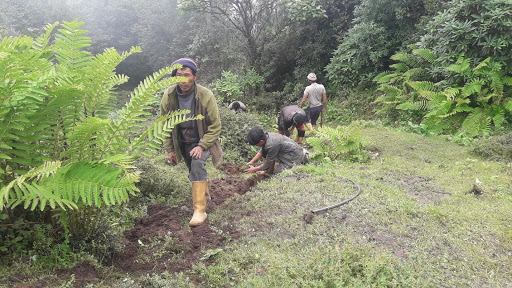We’re working with livestock herders in Nepal to end a water crisis and save red panda habitat.
“These animals are everything to me.”
Santiram Bista is referring to the cows, goats and buffalo he raises to make butter or ghiu, and crushed butter (locally known as churpi). Bista, a 59-year-old father of five from Phungling Municipality-11 in eastern Nepal’s Taplejung district, has been a herder for thirty years. He knows the importance of his livestock— “Without them, I can’t support my family.”
Bista is also one of nine local herders living in a water crisis.
Like all high-mountain herders in the Panchthar-Ilam-Taplejung (PIT) corridor of eastern Nepal, Bista faces numerous daily challenges to his survival — but water scarcity is devastating. Herders often have to walk for miles in search of clean drinking water and many herders suffer from water-borne diseases on a regular basis, due to contaminated water.
This harsh life is the only one these herders have ever known.

Santiram Bista with livestock.
“I always had a routine to walk 1 to 1.5 hours to collect drinking water,” Bista shared, referring to a filthy — red and black in color — waterhole that would fill up during monsoons.
His goth resides adjacent to the renowned Pathibhara temple which attracts thousands of pilgrims every year who pass by his goth: a herder’s temporary shed.
“I was also embarrassed to offer tea for travelers or pilgrims crossing by my goth. They weren’t comfortable drinking the water and neither was I.”
The communities in the PIT corridor are mostly agro-pastoralist, who live by a mix of livestock herding and farming. Livestock herding is an age-old practice in Nepal that is vital to the national economy and livelihoods of hundreds of rural community members and their families. Unfortunately, with thousands of livestock in the area, unsustainable herding practices are a major driver of red panda habitat loss, fragmentation and degradation in the PIT corridor.

This used to be a drinking water source for Bista and his family.

Local herders installing pipe for drinking water.
Panjo Lama, a field technician for Himali Conservation Forum (HCF) — RPN's local community partner organization — was returning from restoring water holes in Dhade, Harkate when he came in contact with Bista who shared his concerns for local water scarcity.
Lama saw the severity of the situation and began working with the herders and RPN in restoring a pond in a nearby pasture that serves as a water source for their cattle and wildlife of the area.
The herders were provided with 14 coils of 16 mm and 20 mm drinking water pipe, along with 2 intake drums and water taps. They spent 15 days installing and channeling pipe, connecting their herder sheds to water (intake) tanks; drums with a natural sediment filter have also been installed near the source (a natural spring) to store the clean water. Learn more in the video below:
Bista and other herders are now thankful to have clean water to drink. They also made a commitment to conservation: from planting trees to helping Red Panda Network (RPN) construct waterholes and ponds for wildlife to adopting sustainable herding practices, herders have been joining us in preserving the local forest and conserving red pandas.
RPN has formed livestock herding management committees to support sustainable herding practices and initiate environmentally sustainable herding practices in the PIT corridor. We have supported livestock herders with 36 portable canvas tents and improved cookstoves — 46 traditional herding sheds have also been improved in the PIT corridor — to reduce fuelwood consumption and local deforestation. Numerous conservation workshops have been held to educate herders on sustainable herding practices that include stall-feeding, improved sanitation, and proper management and disposal of livestock waste. Additionally, we developed a “Pastureland Management Manual'' in the Nepali language that was used to guide the herder workshops.

Local herder with new portable canvas tent.
In order to facilitate alternative income streams for herders in the PIT corridor, RPN has developed a “Goth-stay Tourism Manual”. The manual guidelines will assist in promoting goth-stay tourism which is where a herder offers accommodation to tourists who gain a unique experience of the nomadic herder lifestyle and the incredible forest-home of red pandas and other wildlife.
Our goth-stay tourism initiative is primarily focused on Panchthar district. A cooking and goth-stay management training will be held to prepare herders in basic hospitality techniques and etiquette. We will also provide in-kind support of kitchen utensils and bedding and are planning for distribution to herders.
Goth-stay tourism is an alternative source of income for the herders of the PIT corridor and another step closer to a sustainable life for them and their families. This initiative combined with other conservation programs that provide access to clean drinking water, improved technologies (such as canvas tents and metal cooking stoves) and opportunities for herders to adopt sustainable practices will help ensure a brighter future for people and pandas in the PIT corridor.
Janam Shrestha and Wangchu Bhutia
Red Panda Network

